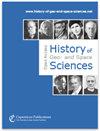聪颖但天生脆弱——地震学家Inge Lehmann直到1930年所经历的社会对女科学家的看法
IF 0.4
4区 哲学
Q4 GEOSCIENCES, MULTIDISCIPLINARY
引用次数: 0
摘要
摘要地震学家英格·莱曼(Inge Lehmann, 1888-1993)因1936年发现地球内核而闻名,她经常被描绘成一位具有令人印象深刻的国际事业的开拓性女科学家。她是丹麦旨在加强科学研究中的性别平等的资助项目背后的灵感来源。然而,新发现的文件显示,莱曼的科学生涯之路并非一帆风顺。当时的社会认为,女性在精神和身体上都不适合学术研究,更不用说从事科学事业了,性别偏见和歧视阻碍了她的抱负,限制了她早期的职业选择。雷曼在给尼尔斯·玻尔的信中记录了她对剑桥大学对女性的限制感到失望和沮丧,这促使她回到了丹麦。1912年冬天,她精神崩溃的原因很可能是学术上为了克服性别偏见而给予的过度补偿。在获得丹麦的数学学位后,她成了大学里一名收入微薄的文员。只有务实地将自己的研究领域从著名的数学转向鲜为人知的地震学,她才能成为一名成功的科学家。本文章由计算机程序翻译,如有差异,请以英文原文为准。
Intellectually gifted but inherently fragile – society's view of female scientists as experienced by seismologist Inge Lehmann up to 1930
Abstract. Celebrated for her 1936 discovery of the Earth's inner core, seismologist Inge Lehmann (1888–1993) is often portrayed as a trailblazing female scientist with an impressive international career. She is the inspiration behind Denmark's funding program designed to strengthen gender equality in scientific research. Yet, newly discovered documents show that Lehmann's path to a career in science was not at all straightforward. In a society where women were considered mentally and physically unsuited to academic studies, let alone scientific careers, gender bias and discrimination thwarted her ambitions and limited her early career options. Lehmann's letters to Niels Bohr document the disappointment and frustration with restrictions on women at Cambridge University that prompted her to return to Denmark. Her mental breakdown in the winter of 1912 likely resulted from academic overcompensation in attempts to overcome gender bias. After obtaining a Danish degree in mathematics, she became an underpaid clerical employee at the university. Only by pragmatically changing her field from prestigious mathematics to little-known seismology could she establish herself as a successful scientist.
求助全文
通过发布文献求助,成功后即可免费获取论文全文。
去求助
来源期刊

History of Geo- and Space Sciences
GEOSCIENCES, MULTIDISCIPLINARY-HISTORY & PHILOSOPHY OF SCIENCE
CiteScore
1.50
自引率
33.30%
发文量
10
审稿时长
50 weeks
期刊介绍:
The scope of History of Geo- and Space Sciences (HGSS) is to document historical facts and knowledge and to improve awareness of the history of geoscience. The knowledge of the development of geosciences and their experimental methods and theories in the past can improve our current understanding and may stimulate current research. It is encouraging for young scientists to read biographical material of historical figures in their research area. It is important as well to learn that history of science is an integrated part of the ongoing research in their research area. Another important aim of the journal is the association of historical retrospective and current research.
 求助内容:
求助内容: 应助结果提醒方式:
应助结果提醒方式:


